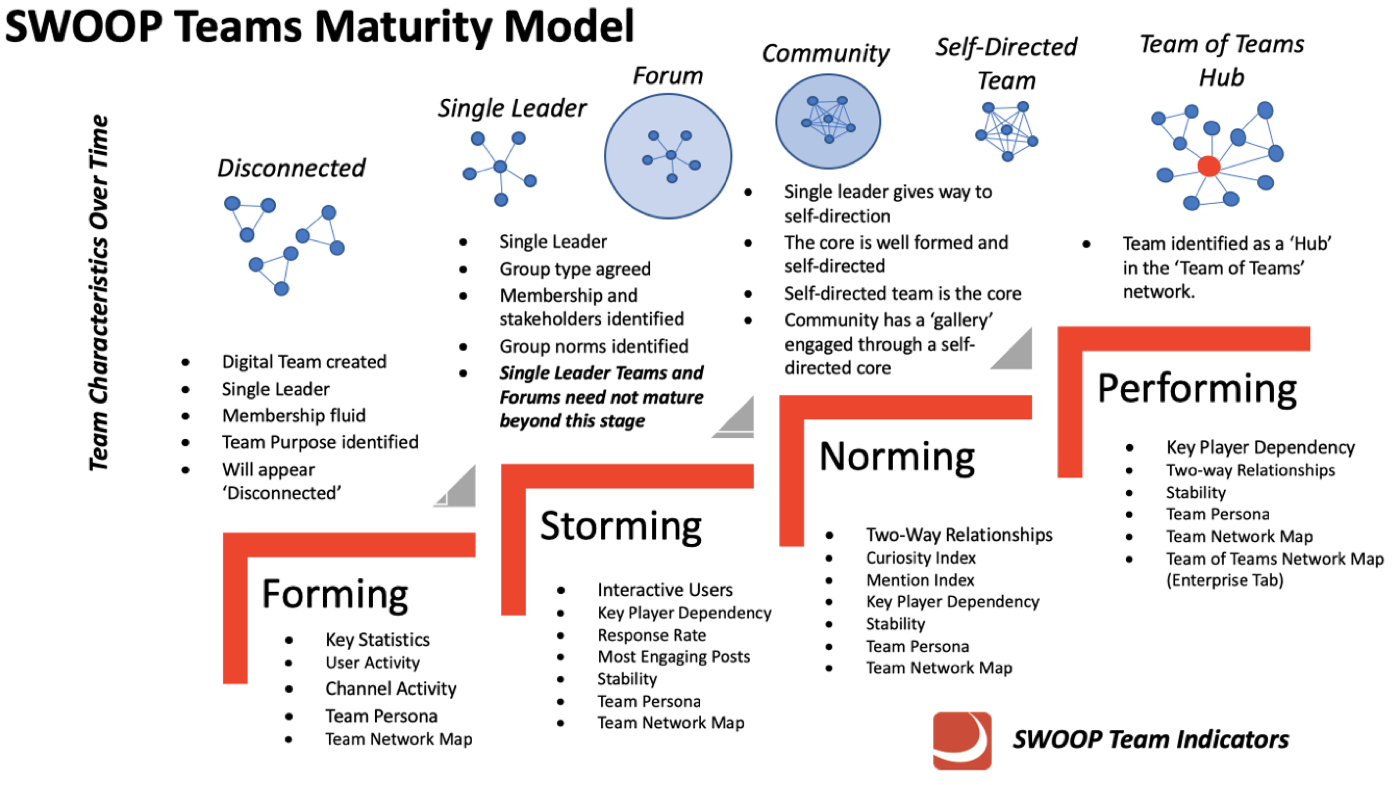The story of a digital team – Forming, Storming, Norming & Performing
Team productivity is strongly linked to relationships formed and sustained by team members. With SWOOP Analytics’ newest product – SWOOP for Microsoft Teams – we can help you identify what type of teams you’re working with and adapt behaviours to help you reach more productive outcomes.
A productive team is more about relationship formation than simply activity, as proved in our 2016 research. If you are relying on activity measures to guide your collaboration and relationship building efforts, you may as well not bother. If you instead define engagement as people engaging with each other in productive collaboration, social cohesion and relationship–centred measures are essential. This is where SWOOP for Teams comes into play.
What Should Team Level Analytics do for Teams?
Quite simply, Team Analytics need to provide productivity insights to both team leaders and their membership. At the enterprise level they should provide insights into the “teaming” performance of the enterprise as a whole. There is no shortage of research studies done on team productivity. At the risk of over–simplifying their insights, we have compiled the following key characteristics of highly productive teams:
A collective and shared understanding of the team’s purpose for existing;
Membership is bounded and stable i.e. it is clear who is in and who is not;
Psychologically safe i.e. openness and honesty welcomed without penalty;
Regularly makes use of the unique strengths of each team member (role clarity);
A shared understanding of what excellence is for the team and the belief that they have the authority to pursue it (excellence mindset); and
A clear understanding in how the Team ‘fits’ in the context of the overall organisation i.e. a supportive business and technical infrastructure.
Microsoft Teams analytics is currently limited to activity and platform resource utilisation data that provide little, if any, insights into teams’ productivity. Even if we were to enlist the use of employee engagement surveys, like those provided by the recently acquired Glint, we can at best anticipate quarterly measures and response rates well short of 100%.
At SWOOP we look to track the teams’ journeys on a daily basis (and sometimes up to hourly, depending on the size of the organisation). Teams can form, grow and disband dynamically. We believe it is important for productivity analytics to match the pulse rate of the teams they are monitoring.
Forming, Storming, Norming and Performing
We have adopted this popular group growth formalism to build the story of how a digital team might monitor its productivity journey from its initial formation, through to the team as a high performing unit having a positive effect on other teams around it.
While the maturity model below infers a linear journey, in reality, not all teams need to run the whole journey to be productive. For example, a team could be highly productive as a single leader team. If the team context is to deliver a product or service using a tried and tested process e.g. commodity products or services, then building a self-directed team may not be the most productive means for achieving the team’s objectives. On the other hand, some teams may mature to becoming a very effective self-directed team but then undergo a change of membership and charter, which could bring them right back to the ‘Forming’ phase again, where a single leader may need to take charge once again.
Making your Microsoft Teams Highly Productive Teams
We have presented a suite of analytics, aligned with a Team’s growth journey, to high productivity. To be truly ‘in the flow’ of day to day work, it requires moving beyond the traditional staff surveys, to real-time measures of team member interactions.
SWOOP for Microsoft Teams will clearly measure the strength and nature of relationships formed online, that identify with high performing teams. We will measure the boundedness and stability of a team; the roles team members are playing and where the team is located in an overall enterprise ‘teaming’ structure.
High productivity teams are centred on strong relationships; precisely what SWOOP was designed to assess.


